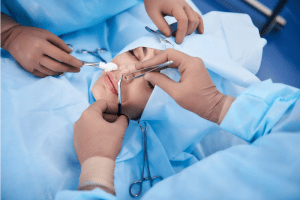If you’ve ever looked into correcting the functionality or appearance of your nose, you’ve likely come across the terms septoplasty and rhinoplasty. And while these two words may sound slightly similar, the actual procedures serve different purposes when it comes to improving your nose.
To put it simply, septoplasty in Los Angeles is a surgery that is performed in order to straighten a deviated nasal septum. Rhinoplasty, on the other hand, is a surgery that changes the shape of the nose primarily for aesthetic reasons. If you’re considering undergoing septoplasty or rhinoplasty but aren’t sure which is right for you, we’ll be comparing everything from the procedures, to the recovery processes, and potential benefits of the two kinds of surgeries in this article.
Understanding Septoplasty in Los Angeles
In order to better understand what septoplasty is, it’s important to know what part of the nose this procedure is intended to correct: the nasal septum. A nasal septum is a wall that divides the nose into two separate chambers (also known as your nasal passages). When a nasal septum is crooked or off-center, it causes one of the nasal passages to be smaller than the other; this is called a deviated septum.
Unfortunately, a deviated septum can result in an abundance of uncomfortable and sometimes painful symptoms. Septoplasty in Los Angeles is a surgical procedure that is performed to mitigate those intolerable symptoms through correcting the deviation and making your septum straight.
The reason for this procedure may sound simple enough, but how do you know if you have a deviated septum? Some signs and symptoms of a deviated septum include: difficulty breathing through the nose, frequent nosebleeds, snoring, dry mouth, poor sleep, nasal or sinus congestion, headaches, and recurring sinus infections. If you have any of these symptoms as a result of a deviated septum, there is a chance that they will only continue to get worse over time. This is why it’s always important to consult with a medical professional to understand if a deviated septum is what is actually causing your symptoms.
In terms of the septoplasty procedure, it is performed under local anesthesia and typically lasts 45 minutes to an hour. The surgeon will make a small incision inside the nostrils which allows them access to the nasal septum.
From there, they will correct the septum by repositioning it to the middle of your nose without breaking the nasal bones. Immediately after the septoplasty is complete, medical staff will monitor you to ensure there aren’t any complications. You can usually go home the same day that your procedure is performed.
Patients who undergo septoplasties don’t have to worry about wearing a cast, and the procedure doesn’t result in any external bruising. You’ll be advised to rest at home for a few days, but you should be recovered and able to participate in normal activities in less than a week. With success rates of up to 85%, septoplasty generally yields positive outcomes when it comes to improving the symptoms caused by a deviated septum.
Understanding Rhinoplasty
Alternatively, rhinoplasty (also known as a “nose job”) is a surgical procedure that is performed to enhance the appearance of the nose by altering its shape or size. It can address a patient’s aesthetic concerns, such as noticeable humps or bumps, a drooping or enlarged nasal tip, wide nostrils, or asymmetry.
There are two kinds of rhinoplasty procedures: open and closed. In an open rhinoplasty, a surgeon will create incisions in order to fully separate the nasal skin from the underlying bone and cartilage. As a result, this approach provides a clear view of the nose’s underlying anatomy which allows for significant reshaping of the nose. A closed rhinoplasty, however, is a less extensive procedure wherein a surgeon makes internal incisions to separate the skin from the bone and cartilage in order to reshape it.
Rhinoplasty surgery can take anywhere from one to three hours. It’s usually an outpatient procedure, so patients are able to go home the same day that the procedure is performed. In a rhinoplasty procedure, the surgeon starts by making incisions either inside the nostrils (closed rhinoplasty) or inside the nostrils and across the base of the nose (open rhinoplasty).
They then lift the skin covering the nasal bones and cartilage and proceed to modify the underlying structures by reducing, adding, or rearranging bone and cartilage to fix any perceived imperfections in order to get the desired shape. Afterwards, the skin is repositioned and then secured with small stitches.
Once your rhinoplasty is complete, you might have a small splint placed in your nose. Splints are used to support the new structure of your nose, and they can also help to reduce any swelling that occurs as a result of the surgery.
However, even with the splint, you should still expect a decent amount of swelling. The swelling should subside after about three months after the procedure, but it can take up to a year for your nose to fully recover and for the swelling to completely go away.
Comparing Septoplasty and Rhinoplasty

In terms of the surgical procedures, septoplasty is typically performed by placing incisions inside the nose. This same approach is used with a closed rhinoplasty, but an open rhinoplasty involves external incisions. The duration of the two procedures may differ, as septoplasties typically take slightly less time to perform than rhinoplasties. Either local or general anesthesia can be used for both surgeries.
The recovery process differs between the procedures, as the recovery time for septoplasty is considerably less than that of rhinoplasty. About one to two weeks of downtime is expected for both, but rhinoplasties can take up to a year to fully heal, whereas septoplasties heal significantly more quickly. Mild to moderate pain or discomfort is to be expected after both.
As with any surgery, septoplasties and rhinoplasties can come with risks and potential complications. There is quite a bit of overlap when it comes to potential risks of both procedures; these risks can include pain, a hole in the septum, excessive bleeding, infections, and scarring (although scarring isn’t as visible for septoplasties and closed rhinoplasties).
Can Septoplasty and Rhinoplasty Be Performed Together?
Septoplasty and rhinoplasty can be performed together in a surgery called a septorhinoplasty. This surgical procedure combines deviated septum repair with correcting cosmetic deformities, giving the patient comprehensive results. While combining the two procedures is much more efficient for patients who are looking to address both issues, septorhinoplasty does involve additional surgical techniques which results in a slightly longer operative time.
Additionally, while septoplasties can be covered by insurance, cosmetic changes to the nose are never covered by insurance companies. This means that a septoplasty will result in an additional out-of-pocket cost to the patient.
Making the Decision: Septoplasty, Rhinoplasty, or Both
There are several factors to consider when making the decision to undergo septoplasty in Los Angeles, rhinoplasty, or both. First, it’s important to understand if your concerns about your nose are mostly related to its function or its physical appearance. If your concern is the former, a septoplasty might be right for you. If it’s the latter, consider opting for a rhinoplasty. If your goal is to improve both, a septorhinoplasty may be your best bet.
Keep in mind, you need to consult with a qualified surgeon before making a final decision on a procedure. They’ll be able to discuss your desired outcomes, explain potential benefits and risks of any procedure that you’re considering, and provide expert guidance based on your specific circumstances.
Conclusion
Understanding the differences between septoplasty and rhinoplasty is key when contemplating either nose correction procedure. Whether you’re considering either (or both), reviewing your options with a surgeon is crucial as they’ll be able to provide you with a comprehensive evaluation, as well as walk you through potential risks and outcomes of the surgeries.
Ultimately, making the right decision when it comes to getting a septoplasty, rhinoplasty, or septorhinoplasty boils down to a combination of personal goals and professional guidance.

